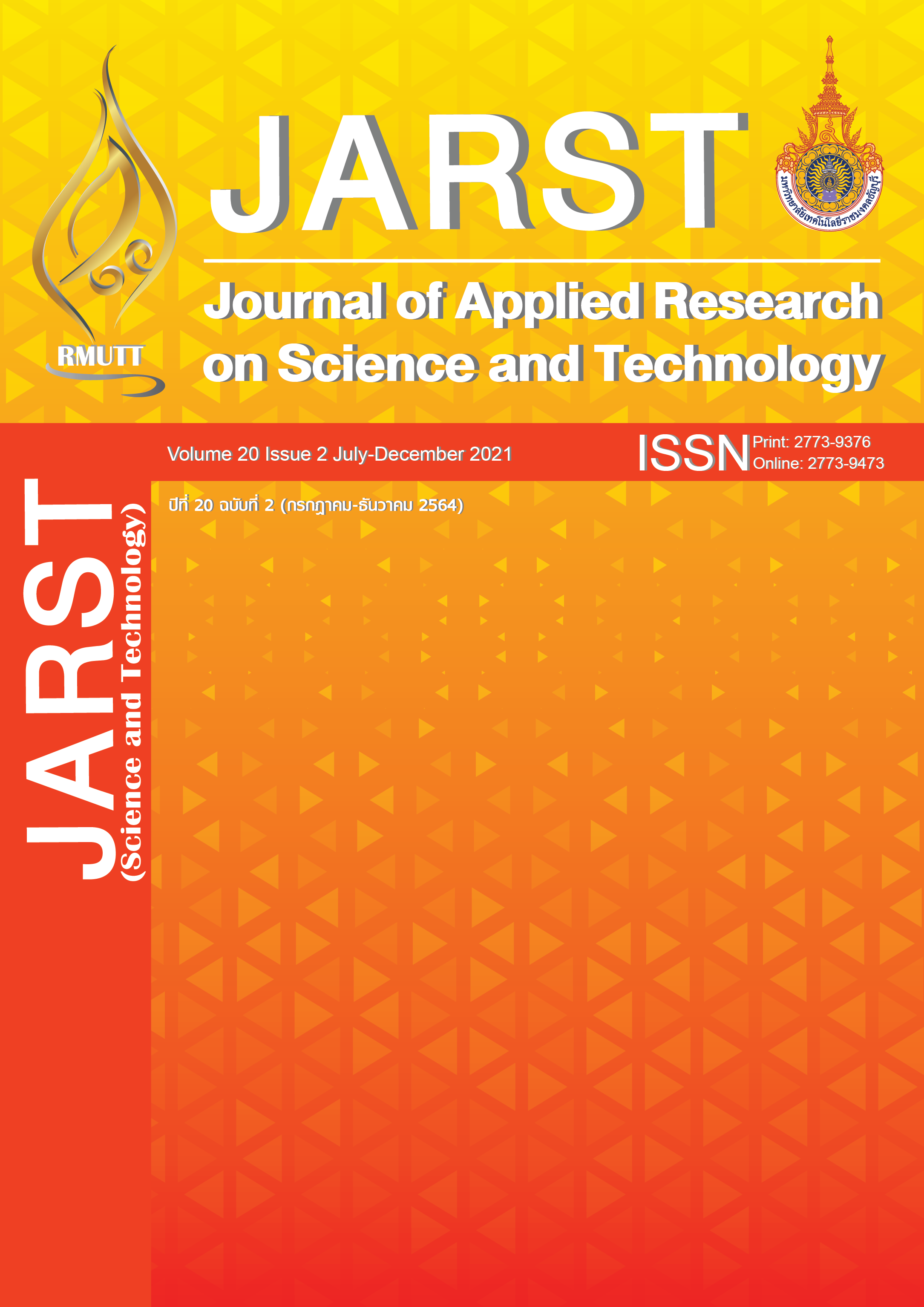Build-up Factors and Fast Neutron Properties of Some Plastic and Polymer for Shielding Materials: A Simulation
Main Article Content
Abstract
This work discussed the theory of radiation shielding for some plastics and polymers. There were 6 samples for this study. They were bone-equivalent plastic (B-100), polyvinyl chloride (PVC), air equivalent plastic (C-552), radio chromic dye film (nylon base), polyethylene terephthalate (mylar) and polymethyl methacrylate (PMMA). These samples were simulated in term of photon and neutron shielding behaviors. Consequently, the theoretical study were separated into 2 types for photon shielding and neutron shielding. The geometrical progression (G-P) method was used to stimulate energy absorption build-up factor (EABF) and exposure build-up factor (EBF), at photon energies ranging from 15 keV to 15 MeV and up to 40 deep penetration mean free path (mfp) for photon shielding. Moreover, fast neutron removal cross-section (SR) values were estimated by partial density method. The data of the simulation were found that equivalent atomic number (Zeq) polymethyl methacrylate (PMMA) had the lowest values whereas EABF and EBF values had maximum values. Furthermore, polyvinyl chloride (PVC) had the highest equivalent atomic number (Zeq) values whereas EABF and EBF values had the lowest values. The result for main interaction of photon with matter can be separated on energy regions that is photoelectric absorption (PE), Compton scattering (C) and pair production (PP) interactions. PE is main interaction at low energies ranging, C is main interaction at intermediate energies ranging and PP is main process at high energies ranging. The results indicated that polyvinyl chloride (PVC) exhibited excellent radiation shielding. Other than fast neutron removal cross-section value (SR) of plastics and polymers, which estimated by partial density method, it was found that radio chromic dye film (nylon base) had the highest value. This result indicated that radio chromic dye film (nylon base) was the excellent neutron shielding material.
Article Details

This work is licensed under a Creative Commons Attribution-NonCommercial-NoDerivatives 4.0 International License.
References
Vishwanath PS, Badiger NM, Chanthima N, Kaewkhao J. Evaluation of gamma-ray exposure buildup factors and neutron shielding for bismuth borosilicate glasses. Radiat Phys Chem. 2014;98:14-21.
Gurler O, Tarim UA. Determination of Radiation Shielding Properties of Some Polymer and Plastic Materials against Gamma-Rays. Acta Phys Pol A. 2016;130:236-8.
Agar O, Kavaz E, Altunsoy EE, Kilicoglu O, Tekin HO, Sayyed MI, et al. Er2O3 effects on photon and neutron shielding properties of TeO2-Li2O-ZnO-Nb2O5 glass system. Results Phys. 2019;13:102277.
Kaur P, Devinder S, Tejbir S. Gamma rays shielding and sensing application of some rare earth doped lead-alumino-phosphate glasses. Radiat Phys Chem. 2018;144:336-43.
Issa SAM, Sayyed MI, Zaid MHM, Matori KA. A comprehensive study on gamma rays and fast neutron sensing properties of GAGOC and CMO scintillators for shielding radiation applications. J Spectrosc. 2017;9792816:1-9.
Tekin HO, Altunsoy EE, Kavaz E, Sayyed MI, Agar O, Kamislioglu M. Photon and neutron shielding performance of boron phosphate glasses for diagnostic radiology facilities. Results Phys. 2019;12:1457-64.
Vishwanath PS, Badiger NM. Gamma ray and neutron shielding properties of some alloy materials. Ann Nucl Energy. 2014;64:301-10.
Kadhim LF. Mechanical properties of high-density polyethylene/chromium trioxide under ultraviolet rays. International Journal of Applied Engineering Research. 2017;12(10):2517-26.
Mahmoud ME, El-Sharkawy RM, Allam EA, Elsaman R, El-Taher A. Fabrication and characterization of phosphotungstic acid - Copper oxide nanoparticles - Plastic waste nanocomposites for enhanced radiation-shielding. J Alloy Compd. 2019;803:768-77.
Mahmoud KA, Lacomme E, Sayyed MI, Ozpolat OF, Tashlykov OL. Investigation of the gamma ray shielding properties for polyvinyl chloride reinforced with chalcocite and hematite minerals. Heliyon. 2020;6:e03560.
Labouriau A, Robison T, Shonrock C, Simmonds S, Cox B, Pacheco A, et al. Boron filled siloxane polymers for radiation shielding. Radiat Phys Chem. 2018;144:288-94.
Sayyed MI, AlZaatreh MY, Matori KA, Sidek HAA, Zaid MHM. Comprehensive study on estimation of gamma-ray exposure buildup factors for smart polymers as a potent application in nuclear industries. Results Phys. 2018;9:585-92.
Şakar E. Determination of photon-shielding features and build-up factors of nickel–silver alloys. Radiat Phys Chem. 2020;172:108778.
Tekin HO, Kilicoglu O, Kavaz E, Altunsoy EE, Almatari M, Agar O, et al. The investigation of gamma-ray and neutron shielding parameters of Na2O-CaO-P2O5-SiO2 bioactive glasses using MCNPX code. Results Phys. 2019;12:1797-804.
Sayyed MI, Elhouichet H. Variation of energy absorption and exposure buildup factors with incident photon energy and penetration depth for boro-tellurite (B2O3-TeO2) glasses. Radiat Phys Chem. 2017;130:335-42.
Dong MG, Sayyed MI, Lakshminarayana G, Ersundud MÇ, Ersundu AE, Nayare P, et al. Investigation of gamma radiation shielding properties of lithium zinc bismuth borate glasses using XCOM program and MCNP5 code. J Non-Cryst Solids. 2017;468:12-6.
Oto B, Yıldız N, Korkutb T, Kavazc E. Neutron shielding qualities and gamma ray buildup factors of concretes containing limonite ore. Nucl Eng Des. 2015;293:166-75.
Da C, Ge Y, Mohamed B, Dan M. Gamma radiation shielding properties of poly (methyl methacrylate) /Bi2O3 composites. Nucl Eng Technol. 2020;52: 2613-19.
Ahmed SO. Development of high–performance heavy density concrete using different aggregates for gamma-ray shielding. Prog Nucl Energ. 2015;79:48–55.

